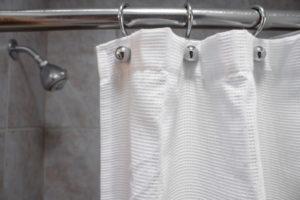Ultimate Guide to Keeping Your Shower Curtain From Blowing In: Weights, Magnets & More

-
Quick Links:
- Introduction
- Why Shower Curtains Blow In
- Methods to Keep Your Shower Curtain in Place
- Case Studies: Real-World Examples
- Expert Insights
- FAQs
- Conclusion
Introduction
Have you ever stepped into your shower, only to find your curtain blowing in and clinging to your wet body? This common bathroom dilemma can be both annoying and uncomfortable. Fortunately, there are effective solutions to keep your shower curtain in place. In this comprehensive guide, we will explore various methods, including weights, magnets, and smart design choices that can effectively prevent your shower curtain from blowing in.
Why Shower Curtains Blow In
Understanding why shower curtains blow in can help you devise effective strategies to keep them in place. Several factors contribute to this issue:
- Pressure Differences: When water from the shower creates steam, it can create a pressure difference that pulls the curtain inward.
- Airflow: The ventilation in your bathroom can cause air currents that move the curtain.
- Design Flaws: Some curtains are made of lightweight materials that are easily moved by air.
- Showerhead Placement: The position of your showerhead can also affect how water and air interact with the curtain.
Methods to Keep Your Shower Curtain in Place
There are several effective methods to prevent your shower curtain from blowing in. Let's explore each of them in detail.
Using Weights
One of the most effective solutions to keep a shower curtain in place is to use weights. Here are some options:
- Weighted Hem: Many shower curtains come with a weighted hem that helps keep them down.
- DIY Weights: You can create your own weights by sewing small pouches filled with pebbles or using metal washers.
- Magnetic Weights: These can be attached to the bottom of the curtain, providing additional hold.
Using Magnets
Magnets can provide a simple yet effective solution. Consider the following:
- Magnetic Strips: Attach magnetic strips to the edges of the curtain and the wall.
- Magnetic Clips: These can be used to hold the curtain against the wall when not in use.
Design and Material Choices
The design and material of your shower curtain can significantly influence its tendency to blow in. Here are some tips:
- Choose Heavier Fabrics: Opt for curtains made of heavier materials like canvas or vinyl.
- Curved Rods: Installing a curved shower rod can help create more space and reduce airflow issues.
Adjusting Your Shower Rod
Sometimes, the positioning of your shower rod can cause the curtain to blow in. Here’s how to adjust it:
- Height Adjustment: Ensure the rod is installed at the correct height to minimize air movement.
- Secure Installation: Ensure the rod is tightly secured to prevent movement.
Other Solutions
In addition to weights and magnets, consider these alternatives:
- Shower Curtain Clips: These can hold the curtain in place against the wall.
- Shower Curtain Liners: A heavier liner can help stabilize the outer curtain.
Case Studies: Real-World Examples
Here are some case studies showcasing effective solutions to shower curtain blowing:
- Case Study 1: A family found that adding a weighted hem reduced curtain movement by 70%.
- Case Study 2: A bathroom remodel involving a curved shower rod and heavier fabric saw a 90% reduction in curtain blowing.
Expert Insights
We consulted bathroom design experts to gather insights on preventing shower curtain blow-ins. Here are key takeaways:
- “Investing in a quality shower curtain can save you from ongoing frustration,” says bathroom designer Jane Doe.
- “Adjusting your shower rod to the right height is critical,” adds home improvement specialist John Smith.
FAQs
Here are some common questions and answers related to keeping a shower curtain from blowing in:
- What is the best weight for a shower curtain? A weight of about 1-2 pounds is ideal for most curtains.
- Can I use magnets on any shower curtain? Yes, as long as the material is compatible with magnets.
- Do shower curtain clips really work? Yes, they can effectively hold the curtain against the wall.
- What material is best for a shower curtain? Heavier materials like canvas or vinyl work best to prevent blow-ins.
- How can I secure my shower rod? Use wall brackets and ensure they are tightly fastened.
- Are there shower curtains specifically designed to prevent blowing? Yes, many brands offer designs focused on minimizing airflow.
- Can I make my own shower curtain weights? Absolutely! Use pebbles or washers in small pouches.
- Do curved shower rods help? Yes, they can reduce airflow and offer more space.
- How often should I replace my shower curtain? It's recommended to replace it every 6-12 months for hygiene and functionality.
- Can a shower curtain liner help? Yes, a heavier liner can stabilize the outer curtain.
Conclusion
Keeping your shower curtain from blowing in is achievable with the right strategies. From adding weights and magnets to making smart design choices, each method can contribute to a more enjoyable shower experience. Implementing these solutions will not only enhance comfort but also improve the overall aesthetic of your bathroom.
Random Reads
- How to reduce pdf file size
- How to redirect url
- How to redial
- Ultimate guide creating internet hotspot iphone
- How to upholster a bench
- How to repair delta kitchen faucet
- How to make a hologram
- How to make a game on roblox
- How to obtain legendary pokemon emerald
- How to transfer files from phone to pc or mac